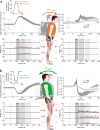Biarticular muscles are most responsive to upper-body pitch perturbations in human standing
- PMID: 31601860
- PMCID: PMC6787002
- DOI: 10.1038/s41598-019-50995-3
Biarticular muscles are most responsive to upper-body pitch perturbations in human standing
Abstract
Balancing the upper body is pivotal for upright and efficient gait. While models have identified potentially useful characteristics of biarticular thigh muscles for postural control of the upper body, experimental evidence for their specific role is lacking. Based on theoretical findings, we hypothesised that biarticular muscle activity would increase strongly in response to upper-body perturbations. To test this hypothesis, we used a novel Angular Momentum Perturbator (AMP) that, in contrast to existing methods, perturbs the upper-body posture with only minimal effect on Centre of Mass (CoM) excursions. The impulse-like AMP torques applied to the trunk of subjects resulted in upper-body pitch deflections of up to 17° with only small CoM excursions below 2 cm. Biarticular thigh muscles (biceps femoris long head and rectus femoris) showed the strongest increase in muscular activity (mid- and long-latency reflexes, starting 100 ms after perturbation onset) of all eight measured leg muscles which highlights the importance of biarticular muscles for restoring upper-body balance. These insights could be used for improving technological aids like rehabilitation or assistive devices, and the effectiveness of physical training for fall prevention e.g. for elderly people.
Conflict of interest statement
The authors declare no competing interests.
Figures




References
-
- Doorenbosch CA, van Ingen Schenau GJ. The role of mono-and bi-articular muscles during contact control leg tasks in man. Hum. Mov. Sci. 1995;14:279–300. doi: 10.1016/0167-9457(95)00020-S. - DOI
-
- Fujiwara M, Basmajian JV. Electromyographic study of two-joint muscles. Am. journal physical medicine. 1975;54:234–242. - PubMed
Publication types
MeSH terms
Grants and funding
LinkOut - more resources
Full Text Sources
Medical

